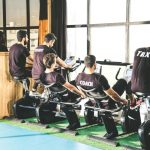Endurance training drills are essential for athletes looking to enhance their stamina and performance in sports. These drills focus on maintaining a steady and sustained level of exertion over prolonged periods, significantly boosting an athlete’s cardiovascular and muscular endurance. Whether through long, slow distance training or high-intensity speed drills, incorporating a variety of endurance exercises can effectively build the strength and stamina needed for optimal athletic performance.
Athletes can benefit immensely from endurance workouts such as long, slow distance runs, tempo training, and interval workouts. For example, an advanced interval routine might include various distances like 400 meters, 800 meters, and 1,600 meters with light jogs in between, which challenges both leg speed and overall endurance. Additionally, drills like farmer’s walks, Romanian deadlifts, and chin-ups also contribute to muscular endurance, making the athlete more resilient and powerful during competitions.
Implementing these diverse endurance training drills within a regular fitness regimen ensures that athletes not only improve their performance but also gain a competitive edge. By consistently pushing their physical limits through these targeted exercises, they lay a solid foundation that supports their success across various sports.
Fundamentals of Endurance Training
Endurance training revolves around enhancing the body’s ability to sustain prolonged physical activity. Key components include aerobic workouts, muscular endurance development, and cardiovascular fitness improvement.
Understanding Endurance
Endurance is the ability to withstand physical exertion over an extended period. It incorporates cardiovascular fitness, aerobic endurance, and muscular endurance. The cardiovascular system, including the heart and lungs, must efficiently deliver oxygen to the muscles.
Maximal oxygen uptake (VO2 max) is a critical measure of endurance. Higher VO2 max levels indicate better endurance as the body can utilize more oxygen. Aerobic fitness is developed through activities like long-distance running, cycling, and swimming, which increase lung capacity and the efficiency of oxygen use.
Components of an Effective Endurance Training Plan
An effective plan should include a variety of workouts, structured phases, and recovery periods.
Aerobic workouts are the foundation. These keep you below your lactate threshold, allowing endurance to build without excessive fatigue. Training should also include base phases focusing on increasing aerobic capacity and muscular strength.
Interval training can improve speed and endurance simultaneously. For example, running intervals on a treadmill with varying speeds and inclines. Long runs are essential for building stamina, gradually increasing distances to avoid injury. Cross-training, like cycling or swimming, can balance the load on different muscle groups and improve overall endurance.
Flexibility and strength training help prevent injuries and ensure smooth progression to more intense workouts. Integrating these components effectively can lead to substantial enhancements in endurance performance.
Building a Strong Foundation
To excel in endurance training, it’s crucial to develop core strength and implement injury prevention techniques effectively. Focusing on these aspects will ensure balanced muscle development and overall stability.
Importance of Core Strength
Core muscles include the abdominals, lower back, and pelvis. Strong core muscles enhance stabilization, aiding in maintaining proper form during long runs or other endurance activities. This reduces strain on joints and tendons, facilitating smoother movements.
Incorporating exercises such as planks, Russian twists, and leg raises targets these muscles effectively. Planks, for instance, should be held for progressively longer durations, focusing on maintaining a flat back and engaged core.
Russian twists with a medicine ball or dumbbell engage the obliques, enhancing rotational strength. Leg raises can also help strengthen the lower abdominals and hip flexors. Including these exercises in a weekly routine ensures the core remains strong and supportive.
Injury Prevention Techniques
Preventing injuries is paramount for long-term endurance training success. Implementing proper warm-up routines, stretching, and strength training are key methods. Performing dynamic stretches before workouts, such as leg swings or arm circles, prepares the muscles and joints for the strains of exercise.
Supporting muscles and tendons need strength to absorb and distribute the impact forces effectively. Exercises like squats and lunges build leg strength, promoting better support.
Additionally, practicing good posture and technique during activities, such as keeping a neutral spine and proper foot alignment, helps minimize strain on specific areas. Regularly incorporating these methods helps reduce the risk of common injuries, such as shin splints and tendonitis.
Drills to Enhance Running Mechanics
Enhancing running mechanics involves drills that focus on improving speed, power, and running economy. These drills target specific aspects such as stride length, proper running form, and muscle engagement.
Drills for Improving Speed and Power
High Knees: This drill helps improve knee lift and running power. Perform by running in place, bringing your knees up to hip level with each step. Keep your back straight and engage your core. Aim for short sets of 20-30 seconds with rest intervals in between.
Butt Kicks: Enhances glute and hamstring engagement. While running, kick your heels up towards your glutes. Maintain a steady pace and ensure that your thighs stay relatively still. Perform this drill for 20-30 seconds for multiple sets.
Forward Lunge: This helps in improving stride length and muscle power. Step forward with one leg, bending both knees to 90 degrees. Push off the front leg to return to the starting position. Alternate legs and aim for 10-15 repetitions on each side.
Bounding: Increases stride length and explosiveness. Leap forward with each step, driving with your arms and engaging your glutes and quads. This drill emphasizes the upward and forward motion, improving overall running mechanics.
Techniques for Better Running Economy
A-Skip: Focuses on coordinated leg and arm movement, promoting efficient running form. Skip forward, lifting your knees and driving your toes upwards. Synchronize arm movements with your legs. Perform for 20-30 meters.
B-Skip: Builds on the A-Skip, extending the leg after lifting the knee. The leg is kicked out in front before returning to the ground. This improves hip flexor strength and promotes better stride mechanics. Repeat for 20-30 meters.
Heel-to-Toe Walk: Reinforces proper foot strike pattern. Walk forward, placing your heel down first and then rolling to the toes. Keep your body upright and engage your core muscles. Perform this for 20-30 seconds.
Running Backwards: Enhances balance and glute engagement. Run backward, focusing on light and quick foot contacts. This drill helps in improving overall running economy by engaging different muscle groups. Perform for 20-30 meters.
Each of these drills, consistently practiced, helps refine specific aspects of running mechanics, aiding in more efficient and powerful runs.
Conditioning Workouts and Exercises
Conditioning workouts enhance cardiovascular health, muscular strength, and overall endurance. These exercises often combine interval and tempo training with resistance routines to achieve balanced physical fitness.
Interval and Tempo Training
Interval training alternates between high-intensity bursts and low-intensity recovery periods. This method improves cardiovascular endurance, speeds up metabolism, and supports fat loss. Hill sprints are a popular type of interval training where running uphill increases leg strength and oxygen intake efficiency.
Tempo runs maintain a steady, challenging pace for an extended period. These runs boost lactate threshold, making it easier to sustain higher speeds with less fatigue over time. Combining both interval and tempo training can result in balanced endurance and strength gains.
Key Points:
- Benefits: Improves cardiovascular health, increases metabolism.
- Typical Workouts: 400m sprints with rest intervals, sustained tempo runs.
- Example: 800m runs with 400m light jogs in between.
Resistance and Strength-Training Workouts
Strength-training exercises improve muscle endurance, power, and metabolic rate. These workouts often involve weightlifting and body-weight movements such as squats, lunges, and push-ups.
Using resistance bands or weights, such as dumbbells, can enhance workout intensity. Training volume—the number of sets and reps—should be adjusted based on individual goals, ranging from muscle hypertrophy to increased strength endurance.
Key Points:
- Benefits: Enhances muscle strength, boosts metabolism.
- Typical Workouts: Weightlifting circuits, resistance band routines.
- Example: Three sets of eight to twelve reps of squats with weights.
Designing an Endurance Training Program
A well-constructed endurance training program balances intensity and volume while incorporating varied and specific training methods to maximize performance and recovery.
Balancing Training Intensity and Volume
Balancing training intensity and volume is crucial for optimizing performance and preventing overtraining. Long, slow distance (LSD) training involves maintaining moderate intensities (60-70% of VO2 max) for extended periods and forming the foundation of endurance training. This approach enhances aerobic capacity and builds a strong base.
Pace/tempo training helps improve the lactate threshold by working at a higher intensity, typically at or just below race pace for 20-30 minutes. Including this in a training plan allows athletes to sustain faster paces more comfortably.
Recovery sessions are equally vital. These low-intensity workouts allow the body to repair and adapt without additional strain. Incorporating easy days ensures that the athlete can handle progressively harder training loads over time.
Incorporating Variety and Specificity
Integrating a variety of training methods keeps the program engaging and addresses different physiological aspects. Fartlek training combines varied paces and terrain, blending speed work with endurance. This method keeps the athlete mentally stimulated and improves both aerobic and anaerobic capabilities.
Specificity is another key factor. Training should reflect the demands of the sport. For instance, a marathon runner requires different preparations than a cyclist. Tailoring the program to include event-specific drills ensures that the adaptations are directly applicable to competition needs.
Incorporating hill workouts and interval sessions can also enhance strength and speed. This variety helps prevent plateaus and overuse injuries, ensuring that training remains effective and balanced.
Nutritional Strategies for Endurance Athletes
Endurance athletes require precise nutritional strategies to optimize performance, recovery, and overall health. Key components include proper hydration, electrolyte balance, and fuel from carbohydrates.
Hydration and Electrolyte Balance
Proper hydration is essential for peak performance. Athletes should consume adequate water before, during, and after training to maintain hydration levels. Dehydration can lead to decreased VO2 max, reducing endurance. Electrolytes such as sodium, potassium, and magnesium are crucial to prevent cramping and maintain fluid balance.
Athletes can monitor hydration status by checking urine color; pale yellow indicates proper hydration. Sports drinks containing electrolytes can be beneficial during long training sessions or events, as they help maintain electrolyte balance.
Including fruits, vegetables, and nuts in the diet can also help replenish electrolytes naturally, supporting muscle function and overall stamina.
Carbohydrates and Performance Fueling
Carbohydrates are the primary fuel source for endurance athletes. They provide the necessary energy to sustain long periods of activity. It is recommended to consume 1-1.2 grams of carbohydrates per kilogram of body weight within the initial 3-5 hours post-exercise.
Pre-training meals should include complex carbohydrates like whole grains, fruits, and vegetables to ensure a slow, steady release of energy. During training, simple carbohydrates such as energy gels or sports drinks can provide quick energy boosts.
Post-training nutrition should combine carbohydrates with protein to aid in muscle repair and replenish glycogen stores. This approach assists in faster recovery and better performance in subsequent training sessions. Including a balance of macronutrients ensures optimal mitochondria function, supporting overall endurance.
Advanced Techniques and Workouts
Enhancing endurance through advanced training techniques can involve incorporating plyometrics and agility drills, as well as focusing on developing speed endurance and explosive power. These strategies help athletes maximize their performance by increasing muscle power, balance, and coordination.
Implementing Plyometrics and Agility Drills
Plyometrics, also known as jump training, involves exercises that enable muscles to exert maximum force in short intervals. Activities like bounding and skipping enhance muscle power and coordination.
For example, athletes can perform high knees and box jumps to improve explosive strength and agility. A typical plyometric routine might include:
- Bounding: 3 sets of 10 bounds per leg
- Box Jumps: 3 sets of 10 jumps
- High Knees: 3 sets of 30 seconds
Agility drills, such as ladder drills and cone drills, improve footwork and balance, crucial for sports requiring quick changes in direction.
Developing Speed Endurance and Explosive Power
Training to develop speed endurance involves combining sprint intervals with resistance training. Sprinting at varied distances, coupled with rest periods, enhances an athlete’s ability to maintain high speeds over longer periods.
A sample workout might include:
- Sprint Intervals: 10×100 meters with 30 seconds rest
- Hill Sprints: 5×50 meters with walking back recovery
To boost explosive power, athletes can use weight sleds or perform plyometric push-ups. These exercises increase muscle power and speed.
Weight sled training includes:
- Sled Pulls: 4 sets of 20 meters at 10% body weight
- Plyometric Push-Ups: 3 sets of 15 reps
By incorporating these techniques, athletes can achieve significant improvements in both their endurance and overall performance.
Recovery and Maintenance for Endurance Training
Proper recovery and maintenance routines are essential for endurance athletes to prevent overtraining and ensure consistent performance. Key aspects include active recovery, rest days, and mobility work for optimal range of motion.
Active Recovery and Rest Days
Active recovery involves engaging in low-intensity physical activities such as light jogging, walking, or swimming. These activities help promote blood circulation, which aids in muscle repair and alleviates soreness.
Rest days are equally important. They allow the body to recuperate from the physical strain of intense workouts. Endurance athletes should schedule at least one rest day per week to prevent injuries and promote overall recovery.
Combining both active recovery and rest days ensures a balanced approach, minimizing the risk of overtraining while maintaining fitness levels.
Mobility Work and Flexibility Training
Mobility work improves joint flexibility and range of motion, crucial for enduring repetitive activities. Activities such as yoga, dynamic stretching, and foam rolling can help maintain and improve mobility.
Flexibility training should be incorporated post-workout during the cool-down phase. Static stretches, held for 30 seconds or more, can aid in muscle relaxation and elongation.
Regular mobility and flexibility sessions reduce the risk of injuries. They prepare the muscles and joints for the demands of endurance training, ensuring that the body remains agile and resilient.








